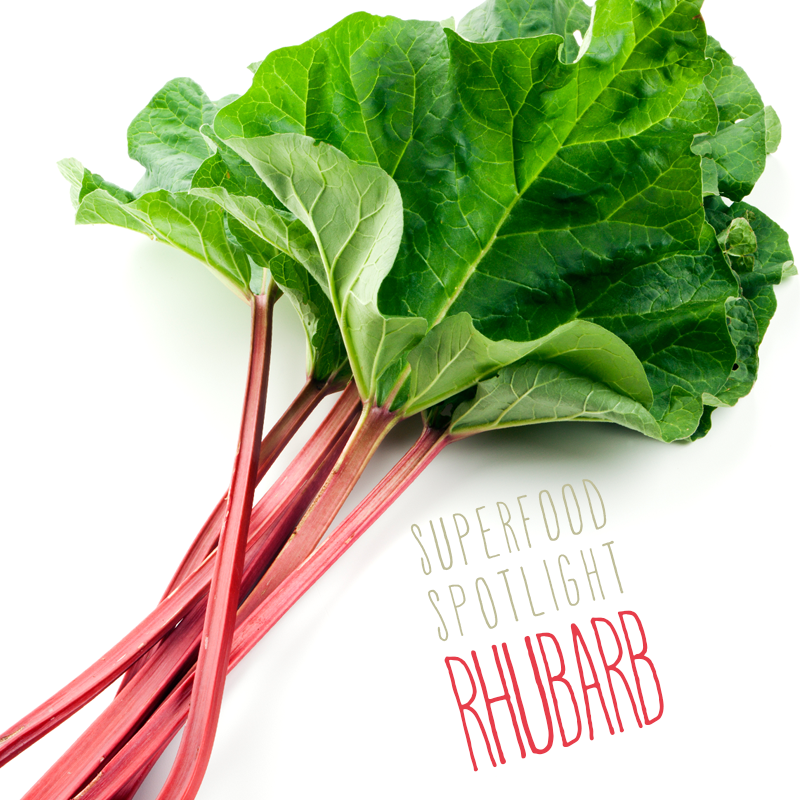If you take a trip to any grocery store, farmers market or supercenter in throughout the United States this week, you’ll likely come across rows of long, rose and green colored stalks of fresh rhubarb. Coming into season near the beginning of spring in colder climates, rhubarb is the perennial harbinger of spring. It sticks around just long enough to say goodbye to winter and hello to summer, giving you enough time to experiment with it in your kitchen and in your diet.

The Epitome of Tart
Contrary to the belief of many people, rhubarb is not in fact red celery. In fact, it grows in different shades of pink and green, too (sort of like how you can find purple and orange cauliflower as well as the customary white). It’s technically a vegetable, though that classification has been debated, as rhubarb is most commonly treated as a fruit. It has an extremely tart flavor when eaten raw (so much so that few people choose to do so) and is instead lovingly referred to as the “pie plant” because one of its most popular purposes is as a pie filling.
Aside from making a fabulous pie filling (and kefir flavor), rhubarb stalks have been used holistically for generations in different cultures throughout the world. Most commonly, rhubarb is used to treatment a variety of digestive troubles, including constipation, heartburn and diarrhea.
It’s important to remember however, to only eat the stalks. Rhubarb leaves contain a variety of poisonous substances, including forms of oxalic acid. While you would need to consume extremely high volumes of rhubarb leaves before they become life-threatening, any leave consumption can result in nausea and vomiting.
Eat Rhubarb, Feel Good
Our warning about rhubarb leaves might cause you to take a step back from diving into the world of rhubarb, but it shouldn’t! Rhubarb is being called by some in the food industry as “the next fruit superfood,” thanks to its impressive nutritional profile.
A one cup (122g raw) serving of rhubarb will set you back only 26 calories and provide you with 2 grams of digestion-friendly fiber (roughly nine percent of the RDA of fiber), as well as:
10 percent RDA of Calcium
Calcium helps build and maintain strong bones. It also enables your heart, nerves and muscles to function properly.
16 percent RDA of Vitamin C
Vitamin C is needed by the body to form the collagen in bones, cartilage, muscle and blood vessels. It also supports healthy immune function
45 percent RDA of Vitamin K
Vitamin K plays a key role in helping blood clot and preventing excessive bleeding. It also plays a role in healthy bone development.
10 percent RDA of Potassium
Studies show that consuming adequate amounts of potassium in your diet is associated with better blood pressure, better cholesterol and regular heart rhythm. Low potassium can also lead to muscle cramps, the bane of runners and exercise enthusiasts world-wide.
12 percent RDA of Manganese
Manganese is essential for normal nerve and brain function. It also plays a role carbohydrate and fat metabolism.
Creative Cooks
Rhubarb is in season right now and we definitely recommend picking some up if you’re feeling adventurous (along with a bottle of our probiotic Limited Edition Hibiscus Rhubarb Pie Lowfat Kefir, of course). The following are some of our favorite ways to enjoy it:
Citrus Hibiscus Rhubarb Pie Kefir Smoothie Bowl
Add 1/3-1/2 cup of fresh chopped rhubarb stalks to the pitcher for an extra splash of tart and tangy goodness.
Kefir Rhubarb Coffee Cake
Top this kefir-ized breakfast treat with a heaping scoop of our Original Frozen Kefir when still warm before serving.
Rhubarb French Toast Crumpets
Replace the whole milk in the batter recipe with our whole milk kefir for and upgraded French Toast with rhubarb berry sauce.
Strawberry Rhubarb Popsicles
Cool down on a warm afternoon with these super simple strawberry and rhubarb popsicles. For a swirl of flavor and fun, make marble popsicles by using one part strawberry-rhubarb mixture with one part Hibiscus Rhubarb Pie Kefir.
Do you love or loathe rhubarb? Let us know by visiting us on Facebook, Twitter and Instagram!